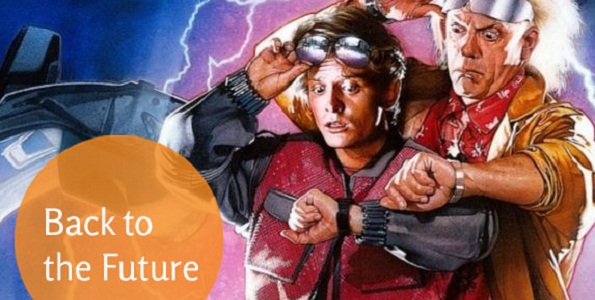Back to the future
I’ve had an absolutely amazing couple of weeks (in a good way) with milestones in both my personal and professional life. I’ll start with what’s happening professionally.
Recently, I found myself attending two lectures on the same day. In the morning I went to a presentation titled The Happy Body at Work, by Anna-Louise Bouvier. In the afternoon I was at UTS’ new Knowledge Economy Institute, learning more about the Internet of Things (IoT). And it occurred to me that not only am I living my dream – combining my passion for wellness and my passion for technology – but also that I’ve created a company based on that dream, one which is at the absolute forefront of the innovation curve and leading the way to the future.
What do I mean by ‘the future’? Well, in one sense, the future’s already here and that’s why I’ve called this blog ‘Back to the Future’. We’re not just headed for, we’re already in, what people are calling the fourth industrial revolution and that revolution’s based on two main things: data and connectivity. Read on!
Regarding data, we’re now able to collect data sets so large and complex that capturing, processing and analysing them poses major challenges. These data are called big data. Regarding connectivity, we’re able to embed physical objects – things – with electronics, software, sensors and network connectivity, so that these objects can talk to each other and share data. This network, of objects embedded with technology they can collect and share, is the IoT (or as Cisco likes to call it the ‘IoE’ – the Internet of Everything). As they develop, these two technological achievements will shape every aspect of our personal, national and global lives.
What does that mean for my company, Springday, and what does it mean for you?
At Springday, we’re moving confidently into the new world. For example, we were accepted by and have moved into ATP Innovations (ATPi). This is based at the National Innovation Centre at the Australian Technology Park, which houses organisations working to commercialise Australian technology and where those organisations can network and collaborate. For example, ATPi helps to facilitate introductions to CSIRO and Data61, the largest data innovation group in Australia (the 61, by the way, refers to our international country code).
We’re also recruiting an in-house data scientist who will work on the metrics associated with big data. The data scientist will drive Springday’s analytics. So, as the size and complexity of data increases, we will keep bringing you new but still reliable ways of managing all aspects of wellness data for you and your company. Critically, using data in this way takes wellbeing out of the realm of the warm and fuzzy and enables intervention based on both fact and science. If you want to know what I mean, read this article in The Conversation, about how big data can improve health.
We’ve got quite a few projects going in the dynamic field of connectivity. One that springs to mind is our new app based on the Apple Health Kit. Our app enables health data you enter on your iPhone to be uploaded onto our Springday software platform and recorded as part of your overall corporate wellbeing plan.
Also, we’re launching a minimal viable product (MVP) project in a hospital setting. (An MVP is a product that can collect the maximum amount of validated learning about customers with the least effort). The project involves wearables and how they can aid recovery. I can’t say too much about it yet, but watch this space. It’s a particularly exciting development because it takes Springday’s platform beyond the general corporate world and into the health industry itself.
What do all these innovations mean for your company? Well, if you’re an early adopter, it means we can bring the future to you pretty much as it happens. If you’re more cautious, you can wait and see how these ideas and applications work, and take them on board later. Seems like a win-win to me.
Now to my personal milestones. The group of schoolgirls I mentioned in my last blog, the ones I’ve been mentoring – well, their app won the national Tech Girls are Superheroes competition! How good is that?
But best for last. My shiny-shiny, clever, curious and kind son, Henry, had his first orientation at his new school today! How’s that for a milestone, and the cherry on the cake of a great couple of weeks?
I hope you’ve had as good a time as I have. Here’s to next week, and the week after that…to the future, in fact.
What’s going on
How a video game helped people make better decisions: more good stuff about what games can do for us. Generally, our decisions are often skewed by biases we don’t even recognise, so researchers developed a computer game to find and reduce those biases – and results were better than expected.
How Google employees cut 3 million calories from their diets: I’m against diet books, because diets don’t work. This article, however, describes how changes to Google’s physical office environment helped employees lose a huge amount of weight. The changes were conscious, measured, and easily achievable by anyone whose workplace has a kitchen, or a break-out room, or even a box of charity lollies at reception…hey, isn’t that all of us?
What is the one sign you have incredible mental toughness: it’s simple and it doesn’t just apply to work, it applies to life as well.
Remote control – how to get the best from virtual teams: gone are the days when we all worked in one place, gossiped in one lunchroom and had face-to-face meetings. Today we work anywhere and our offices are virtual. The problem is that technology’s outstripped our ability to manage virtual teams. UNSW Business School has looked into this and pulled together some examples of what and what not to do, based on experience and best practice.
Calling entrepreneurs – want to be creative? Lose the tie: I might not have taken much notice of this, except it’s by Richard Branson. Let me know what you think of his argument for not wearing a tie.
One in two Australians suffer from a chronic disease: according to data released earlier this year by the Australian Institute of Health and Welfare, 46% of Australians have at least one of 8 chronic diseases, affecting both our wellbeing and our economy. Why is this so, and what should the government do about it?
Tech tips
Generally, I use this section to recommend apps or to point you to cutting-edge tech. This time, however, I’m highlighting a fabulous guide put out by Victorian Health (VicHealth), which lists and rates over 200 healthy living apps.
That means you get to see the apps that rate poorly as well as the five (out of over 200!) that rated three or more stars.
The guide is important because VicHealth has also released a survey which finds that two in five Australians think health and wellbeing apps are trustworthy sources of information.
And another thing
Everything you ever wanted to know about teeth: but were afraid to ask your dentist. Including how to brush them, when to brush them, whether to use toothpaste, does mouthwash help…read this and smile!
Noodles of longevity: China’s economic progress is well known but the vast improvement on the health and longevity of the Chinese people is not so well publicised. Here’s an infographic and a short piece showing the Chinese increase in life expectancy, in comparison to other countries.
About empathy: what’s the best way to help someone who’s suffering? This video reminds us we can only create genuine empathy if we’re brave enough to get in touch with our own fragility.
Thought of the day
The best way to predict your future is to create it
– Abraham Lincoln










